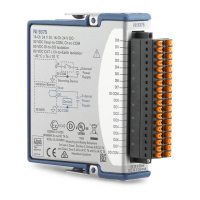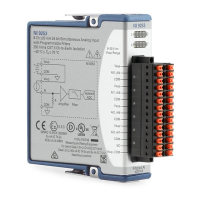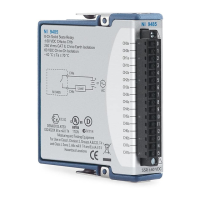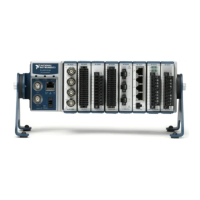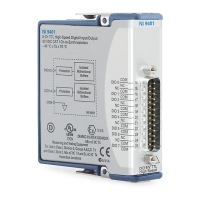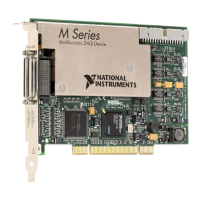NI USB-6008/6009 User Guide and Specifications 12 ni.com
Floating Signal Sources
A floating signal source is not connected to the building ground system, but has an isolated
ground-reference point. Some examples of floating signal sources are outputs of transformers,
thermocouples, battery-powered devices, optical isolators, and isolation amplifiers. An instrument or
device that has an isolated output is a floating signal source.
Refer to the NI Developer Zone document, Field Wiring and Noise Considerations for Analog Signals,
for more information. To access this document, go to ni.com/info and enter the Info Code rdfwn3.
When to Use Differential Connections with Floating Signal Sources
Use DIFF input connections for any channel that meets any of the following conditions:
• Your application requires input ranges other than ±10 V.
• The input signal is low level and requires greater accuracy.
• The leads connecting the signal to the device are greater than 3 m (10 ft).
• The input signal requires a separate ground-reference point or return signal.
Table 6. Analog Input Configurations
Analog Input Mode
Floating Signal Sources
(Not Connected to Building Ground)
Ground-Referenced Signal Sources
Examples:
• Ungrounded thermocouples
• Signal conditioning with isolated
outputs
• Battery devices
Example:
• Plug-in instruments with
non-isolated outputs
Differential (DIFF)
Referenced
Single-Ended (RSE)
+
–
+
–
AI+
AI–
GND
Signal Source NI USB-6008/6009
+
–
+
–
AI+
AI–
GND
Signal Source NI USB-6008/6009
+
–
+
–
AI
GND
Signal Source NI USB-6008/6009
Ground-loop potential (V
A
– V
B
) are added
to measured signal.
NOT RECOMMENDED
+
–
+
–
AI
GND
V
B
V
A
Signal Source NI USB-6008/6009
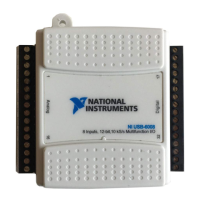
